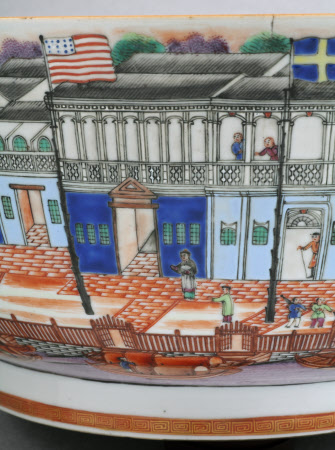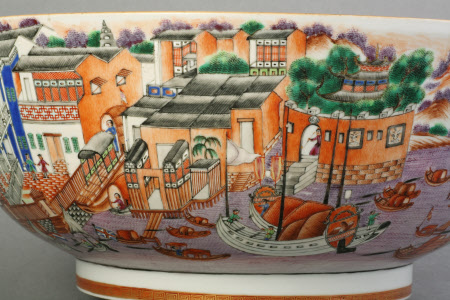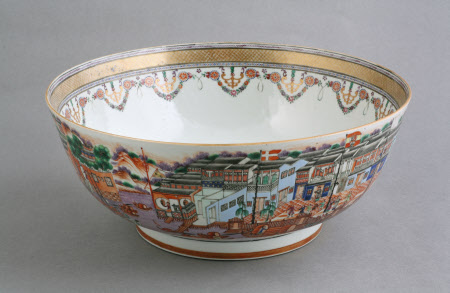Chinese porcelain punchbowl showing the hongs at Canton
Category
Ceramics
Date
1786 - 1788
Materials
Porcelain, polychrome enamels, gilding.
Measurements
15 cm (Height); 37 cm (Diameter)
Order this imageCollection
Nostell Priory, West Yorkshire
NT 959642
Caption
The decoration on this unusual punchbowl reveals that it was made at a very specific time and place as a souvenir for Western merchants working in China. Dating from around 1786–8, the painted scene on the bowl depicts a hong – a stretch of dwellings, offices and warehouses along the river outside Guangzhou (Canton), which was designed as one of several trading posts for Westerners. At this period, Chinese rulers wanted to control Western influence, so they ensured that only licensed foreign merchants worked in secure trading compounds. Flying above the buildings are the national flags of Denmark, Spain, France, Britain, Sweden, the Netherlands and the USA, thus revealing the various countries that competed to export Chinese tea, silk and fine porcelain back to the West. The bowl, which is made of porcelain, was probably purchased in China and brought to England by a returning merchant. However, it is not known why it came to Nostell, and it may have been an unusual second-hand gift.
Summary
Hard-paste porcelain decorated in enamel, punch bowl depicting the hongs or trading premises of western merchants along the waterfront at Guangzhou (Canton), the bowl made at Jingdezhen (produced by unknown workshop and kiln), painted in Guangzhou (by unknown painting workshop), China, c. 1788.
Full description
This punchbowl, and the sweet alcoholic drink it was designed to contain, exemplifies late 18th-century Britain’s growing global empire and international trade links, stretching from China to the Caribbean. The basic vessel was made for export in the Chinese porcelain centre of Jingdezhen. From there it was transported south to Guangzhou (known to Europeans as Canton) on the Pearl River and decorated in one of the city’s enamel workshops as a limited edition, high-class souvenir for Westerners involved in trade with China. (1) Using a Western-style single-point perspective, the beautifully detailed illustration around the bowl’s outside depicts a contemporary view of riverside 'hongs' outside Guangzhou. These combined offices, warehouses and living spaces were designed to contain a limited number of annually licensed Western merchants within a secure compound. The flags of several nations are visible: Denmark, Spain, France, Britain, Sweden, the Dutch Republic and the U.S.A. This combination, plus the French flag of pre-1789 design and one or two other details, suggest a date of creation of around 1788. (2) The 'hongs' were part of a Chinese policy intended from the later 18th century to restrict trade with the West. The Chinese state had little interest in what the West had to offer other than silver and instead prioritised security and preventing unwanted external cultural influences. By contrast, Western consumer demand for Chinese goods, especially tea, silk and fine porcelain, continued to grow, creating a huge trade imbalance. This led the British in particular to turn to shipping highly addictive and illegal opium into China from India. This would be a key cause of a series of wars with China in the 19th century. It is unclear how this example of a ‘hong bowl’ arrived at Nostell, where it is first listed in an 1806 inventory. (3) The Winn family had no direct links with international trade and so it was probably bought second-hand, or given as a gift to Sir Rowland Winn, 6th Baronet (1775–1805) as a talking point. (Matthew Constantine, 2019) Notes (1) Ferguson 2016, pp. 152–3. See also Taylor 2017, pp. 121–3. (2)Ferguson 2009, passim. (3) Related punchbowls depicting the 'hongs' are in the British Museum, inv. no. Franks.746.+ (https://www.britishmuseum.org/collection/object/A_Franks-746-, accessed February 2021), and in the National Museum of American History, ID no. CE.61.8, accession no. 234613 (https://americanhistory.si.edu/collections/search/object/nmah_587576, accessed February 2021).
Provenance
Recorded as being at Nostell Priory in the 1806 probate inventory of Sir Rowland Winn, 6th Baronet (1775-1805) and thence by descent; acquired by the National Trust by private treaty in 2008 with grants from the Royal Oak Foundation, the Art Fund and the V&A Purchase Grant Fund.
References
Ferguson, 2009: Patricia F. Ferguson, ‘Canton Revisited: A “Hong” Bowl at Nostell Priory’, National Trust Historic Houses and Collections Annual, London, Apollo in association with the National Trust, 2009, pp. 18–23. Ferguson 2016: Patricia F. Ferguson, Ceramics: 400 Years of British Collecting in 100 Masterpieces, Philip Wilson Publishers, 2016, pp. 152-3. Taylor, 2017: Clare Taylor, ‘Creative Interactions: Chinoiserie in Eighteenth-Century Britain’, in Emma Barker (ed.), Art, Commerce and Colonialism 1600-1800, Manchester, Manchester University Press and Open University, 2017, pp. 115–51., at pp. 121-3.




































